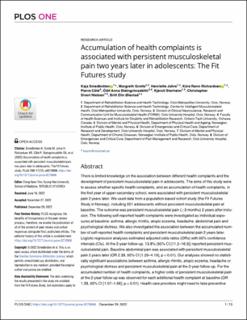| dc.description.abstract | There is limited knowledge on the association between different health complaints and the development of persistent musculoskeletal pain in adolescents. The aims of this study were to assess whether specific health complaints, and an accumulation of health complaints, in the first year of upper-secondary school, were associated with persistent musculoskeletal pain 2 years later. We used data from a population-based cohort study (the Fit Futures Study in Norway), including 551 adolescents without persistent musculoskeletal pain at baseline. The outcome was persistent musculoskeletal pain (≥3 months) 2 years after inclusion. The following self-reported health complaints were investigated as individual exposures at baseline: asthma, allergic rhinitis, atopic eczema, headache, abdominal pain and psychological distress. We also investigated the association between the accumulated number of self-reported health complaints and persistent musculoskeletal pain 2 years later. Logistic regression analyses estimated adjusted odds ratios (ORs) with 95% confidence intervals (CIs). At the 2-year follow-up, 13.8% (95% CI [11.2–16.9]) reported persistent musculoskeletal pain. Baseline abdominal pain was associated with persistent musculoskeletal pain 2 years later (OR 2.33, 95% CI [1.29–4.19], p = 0.01). Our analyses showed no statistically significant associations between asthma, allergic rhinitis, atopic eczema, headache or psychological distress and persistent musculoskeletal pain at the 2-year follow-up. For the accumulated number of health complaints, a higher odds of persistent musculoskeletal pain at the 2-year follow-up was observed for each additional health complaint at baseline (OR 1.33, 95% CI [1.07–1.66], p = 0.01). Health care providers might need to take preventive actions in adolescents with abdominal pain and in adolescents with an accumulation of health complaints to prevent development of persistent musculoskeletal pain. The potential multimorbidity perspective of adolescent musculoskeletal pain is an important topic for future research to understand the underlying patterns of persistent pain conditions in adolescents. | |
